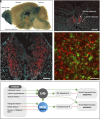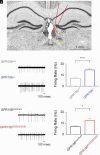A rare variant in GPR156 associated with depression in a Mennonite pedigree causes habenula hyperactivity and stress sensitivity in mice
- PMID: 40228124
- PMCID: PMC12037005
- DOI: 10.1073/pnas.2404754122
A rare variant in GPR156 associated with depression in a Mennonite pedigree causes habenula hyperactivity and stress sensitivity in mice
Abstract
Major depressive disorder (MDD) is a leading cause of disability worldwide. Risk for MDD is heritable, and the genetic structure of founder populations enables investigation of rare susceptibility alleles with large effect. In an extended Old Order Mennonite family cohort, we identified a rare missense variant in GPR156 (c.1599G>T, p.Glu533Asp) associated with a two-fold increase in the relative risk of MDD. GPR156 is an orphan G protein-coupled receptor localized in the medial habenula, a region implicated in mood regulation. Insertion of a human sequence containing c.1599G>T into the murine Gpr156 locus induced medial habenula hyperactivity and abnormal stress-related behaviors. This work reveals a human variant that is associated with depression, implicates GPR156 as a target for mood regulation, and introduces informative murine models for investigating the pathophysiology and treatment of affective disorders.
Keywords: GPR156; genetics; major depressive disorder; medial habenula; orphan G protein-coupled receptor.
Conflict of interest statement
Competing interests statement:J.S., S.M., J.D.O., A.R.S., R.S.B., S.B., A.N.E., E.L.P., J.R., B.Y., D.L., E.S., S.A.D.G., S.M., S.D.C., L.E.M., N.A.-H. are full-time employees of the Regeneron Genetics Center or Regeneron Pharmaceuticals Inc. and receive salary and stock options as part of compensation. C.G.-J. and C.V.H. were full-time employees of the Regeneron Genetics Center at the time of study and received salary and stock options as part of compensation., C.G.-J., N.A.-H., R.B., S.C., J.R., and S.B. are inventors on patent US-20230123787-A1. C.G.-J. is an inventor on patent US-2020231651-A1.
Figures





References
-
- World Health Organization, Depression and Other Common Mental Disorders: Global Health Estimates (World Health Organization, 2017) https://apps.who.int/iris/handle/10665/254610.
-
- Malhi G. S., et al. , Primary prevention of mood disorders: A primary concern that requires urgent action. J. Am. Acad. Child Adolesc. Psychiatry 57, 629–631 (2018). - PubMed
MeSH terms
Substances
Grants and funding
LinkOut - more resources
Full Text Sources
Medical
Molecular Biology Databases

